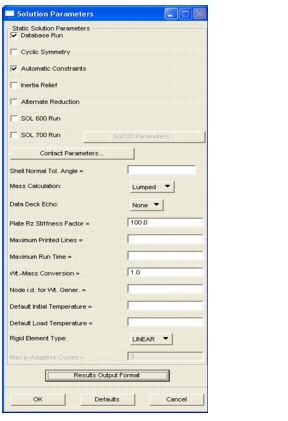

Database Run | Indicates whether a Structured Solution Sequence (SOL 101 or 114) is to be used or a Rigid Format (SOL 1 or 47). If selected, a Structured Solution Sequence is selected. |
Cyclic Symmetry | Indicates that this model is a sector of a cyclically repeating part (SOL 114 or 47). |
Automatic Constraints | Indicates that an AUTOSPC entry is requested, so that MD Nastran will constrain model singularities. |
Inertia Relief | Indicates that the inertia relief flags are to be set by including the PARAM, INREL,-1 command. This flag can only be chosen if Database Run is selected and Cyclic Symmetry is disabled. If inertia relief is selected, a node-ID for weight generation must be selected. A PARAM, GRDPNT and a SUPORT command will be written to the input file using the same node-ID selected for weight generation. The SUPORT entry will specify all 6 degrees of freedom. |
Alternate Reduction | Indicates that an alternate method of performing the static condensation is desired. The PARAM, ALTRED,YES command is included if selected and if Database Run is also selected |
SOL 600 Run | Indicates a SOL 600 run. |
Contact Parameters | Same as the contact parameters available for the Implicit Nonlinear solution type. Only used with linear contact capability. |
Shell Normal Tolerance Angle | Indicates that MD Nastran will define grid point normals for a Faceted Shell Surface based on the Tolerance Angle. This data appears on a PARAM, SNORM entry. |
Mass Calculation | Defines how the mass matrix is to be treated within MD Nastran. This controls the setting of the COUPMASS parameter. This parameter can be set to either Coupled or Lumped. If set to Coupled, COUPMASS will be set to +1, otherwise, it will be set to -1. |
Data Deck Echo | Indicates how the data file entry images are to be printed in the MD Nastran print file. This controls the setting used for the ECHO Case Control command. This parameter can have one of three settings: Sorted, Unsorted, or None. |
Plate Rz Stiffness Factor | Defines the in plane stiffness factor to be applied to shell elements. This defines the K6ROT parameter. This is an alternate method to suppress the grid point singularities and is intended primarily for geometric nonlinear analysis. |
Maximum Printed Lines | Limits the size of the MD Nastran print file that will be generated. This defines the setting of the MAXLINES Case Control command. |
Maximum Run Time | Limits the amount of CPU time expressed in CPU minutes that can be used by this run. This is used to prevent runaway jobs. This defines the setting of the TIME Executive Control statement. |
Wt-Mass Conversion | Defines the conversion factor between weight and mass measures. This defines the setting of the WTMASS parameter. |
Node ID for Wt. Gener. | Indicates the node ID that is to be used for the Grid Point Weight Generator. This is the GRDPNT parameter. |
Default Initial Temperature | Defines the Default Initial Temperature: TEMPD value for subcase entry TEMP(INITIAL) |
Default Load Temperature | Defines the Default Load Temperature: Sets the TEMPD value for the subcase entry TEMP(LOAD) subcase entry. |
Rigid Element Type: | The Rigid element type optionmenu presents three different types of rigid elements, corresponding to the three possible values for the Nastran RIGID= case control. They are:  • LINEAR: Selects linear rigid elements, which are the rigid elements that have been available in MD Nastran since its inception. • LAGR: Selects the new Lagrange rigid elements with the Lagrange multplier method. • LGELIM: Selects the new Lagrange rigid elements with the Lagrange elimination method. See the Nastran quick reference quide for more details. |
Results Output Format | On the Results Output Format form you choose which output formats you want to use with your solution type. For more details, please see Results Output Format, 340. |
Database Run | Cyclic Symmetry | SOL |
On | Off | 101 |
On | On | 114 |
Off | Off | 1 |
Off | On | 47 |
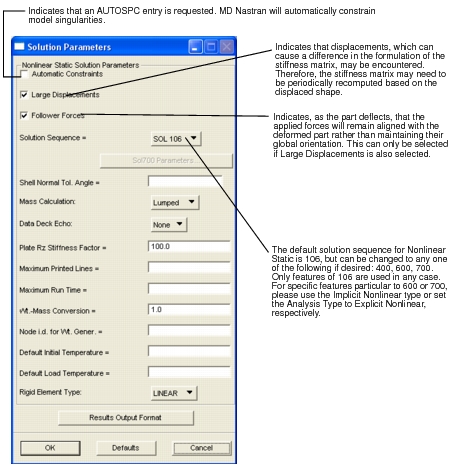
Large Displacements | Follower Forces | LGDISP |
Off | On | -1 |
On | On | 1 |
On | Off | 2 |
Parameter Name | Description |
Mass Calculation | Defines how the mass matrix is to be treated within MD Nastran. This controls the setting of the COUPMASS parameter. This parameter can be set to either Coupled or Lumped. If set to Coupled, COUPMASS will be set to +1, otherwise, it will be set to -1. |
Data Deck Echo | Indicates how the data file entry images are to be printed in the MD Nastran print file. This controls the setting used for the ECHO Case Control command. This parameter can have one of three settings: Sorted, Unsorted, or None. |
Plate Rz Stiffness Factor | Defines the in plane stiffness factor to be applied to shell elements. This defines the K6ROT parameter. This is an alternate method to suppress the grid point singularities and is intended primarily for geometric nonlinear analysis. |
Maximum Printed Lines | Limits the size of the MD Nastran print file that will be generated. This defines the setting of the MAXLINES Case Control command. |
Maximum Run Time | Limits the amount of CPU time expressed in CPU minutes that can be used by this run. This is used to prevent runaway jobs. This defines the setting of the TIME Executive Control statement. |
Wt-Mass Conversion | Defines the conversion factor between weight and mass measures. This defines the setting of the WTMASS parameter. |
Node ID for Wt. Gener. | Indicates the node ID that is to be used for the Grid Point Weight Generator. This is the GRDPNT parameter. |
Results Output Format | On the Results Output Format form you choose which output formats you want to use with your solution type. For more details, please see Results Output Format, 340. |
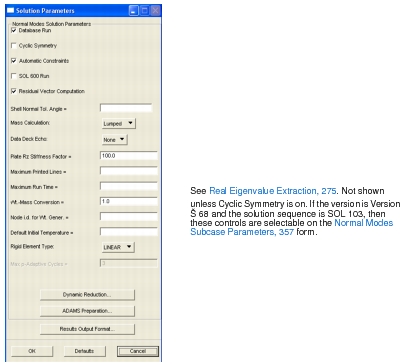
Database Run | Cyclic Symmetry | SOL |
On | Off | 103 |
On | On | 115 |
Off | Off | 3 |
Off | On | 48 |
Parameter Name | Description |
Cyclic Symmetry | Indicates that this model is a sector of a cyclically repeating part (SOL 115 or 48). |
Automatic Constraints | Indicates that an AUTOSPC entry is requested, so that MD Nastran will constrain model singularities. |
SOL 600 Run | Select this to perform a SOL 600 analysis. |
Residual Vector Computation | The Residual Vector Computation toggle writes RESVEC=YES or RESVEC=NO to the Case Control. This calculates residual vectors due to applied loads. The default is to calculate residual vectors. |
Shell Normal Tolerance Angle | Indicates that MD Nastran will define grid point normals for a Faceted Shell Surface based on the Tolerance Angle. This data appears on a PARAM, SNORM entry. |
Mass Calculation | Defines how the mass matrix is to be treated within MD Nastran. This controls the setting of the COUPMASS parameter. This parameter can be set to either Coupled or Lumped. If set to Coupled, COUPMASS will be set to +1, otherwise, it will be set to -1. |
Data Deck Echo | Indicates how the data file entry images are to be printed in the MD Nastran print file. This controls the setting used for the ECHO Case Control command. This parameter can have one of three settings: Sorted, Unsorted, or None. |
Plate Rz Stiffness Factor | Defines the in plane stiffness factor to be applied to shell elements. This defines the K6ROT parameter. This is an alternate method to suppress the grid point singularities and is intended primarily for geometric nonlinear analysis. |
Maximum Printed Lines | Limits the size of the MD Nastran print file that will be generated. This defines the setting of the MAXLINES Case Control command. |
Maximum Run Time | Limits the amount of CPU time expressed in CPU minutes that can be used by this run (used to prevent runaway jobs). This defines the setting of the TIME Executive Control statement. |
Wt-Mass Conversion | Defines the conversion factor between weight and mass measures. This defines the setting of the WTMASS parameter. |
Node ID for Wt. Gener. | Indicates the node ID that is to be used for the Grid Point Weight Generator. This is the GRDPNT parameter. |
Default Inital Temperature | Specify the initial temperature. |
Rigid Element Type | There are three ways to define a rigid element. They are 1) Linear, 2) Lagrangian, or 3) Lgelim. |
Max p-Adaptive Cycles | Specify the maximum number of p-Adaptive cycles. |
Brings up the Dynamic Reduction Parameters form for defining the dynamic reduction controls. | |
Results Output Format | On the Results Output Format form you choose which output formats you want to use with your solution type. For more details, please see Results Output Format, 340. |
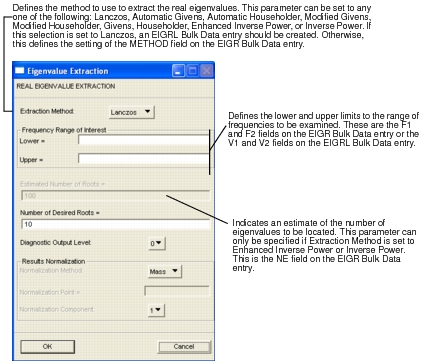
Parameter Name | Description |
Number of Desired Roots | Indicates the limit to how many eigenvalues to be computed. This is the ND field on the EIGR or EIGRL Bulk Data entries. |
Diagnostic Output Level | Defines the level of desired output. This can take any integer value between 0 and 3. This parameter can only be specified if Extraction Method is set to Lanczos. This is the MSGLVL field on the EIGRL Bulk Data entry. |
Normalization Method | Indicates what type of eigenvalue normalization is to be done. This parameter can take one of three settings: Mass, Maximum, or Point. This parameter cannot be specified if Extraction Method is set to Lanczos. Defines the setting of the NORM field on the EIGR Bulk Data entry. |
Normalization Point | Defines the point to be used in the normalization. This can only be selected if Normalization Method is set to Point. This parameter cannot be specified if Extraction Method is set to Lanczos. This is the G field on the EIGR Bulk Data entry. |
Normalization Component | Defines the degree-of-freedom component at the Normalization Point to be used. This can only be selected if Normalization Method is set to Point. This parameter cannot be specified if Extraction Method is set to Lanczos. This is the C field on the EIGR Bulk Data entry. |
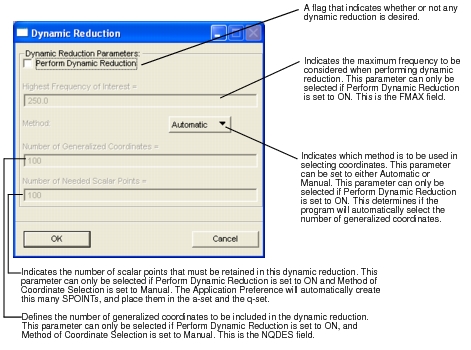
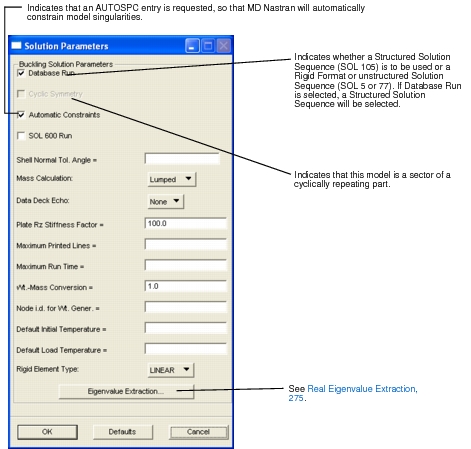
Database Run | Cyclic Symmetry | SOL |
On | Off | 105 |
On | On | 77 |
Off | Off | 5 |
Parameter Name | Description |
Mass Calculation | Defines how the mass matrix is to be treated within MD Nastran. This controls the setting of the COUPMASS parameter. This parameter can be set to either Coupled or Lumped. If set to Coupled, COUPMASS will be set to +1, otherwise, it will be set to -1. |
Data Deck Echo | Indicates how the data file entry images are to be printed in the MD Nastran print file. This controls the setting used for the ECHO Case Control command. This parameter can have one of three settings: Sorted, Unsorted, or None. |
Plate Rz Stiffness Factor | Defines the in plane stiffness factor to be applied to shell elements. This defines the K6ROT parameter. This is an alternate method to suppress the grid point singularities and is intended primarily for geometric nonlinear analysis. |
Maximum Printed Lines | Limits the size of the MD Nastran print file that will be generated. This defines the setting of the MAXLINES Case Control command. |
Maximum Run Time | Limits the amount of CPU time expressed in CPU minutes that can be used by this run. This is used to prevent runaway jobs. This defines the setting of the TIME Executive Control statement. |
Wt-Mass Conversion | Defines the conversion factor between weight and mass measures. This defines the setting of the WTMASS parameter. |
Node ID for Wt. Gener. | Indicates the node ID that is to be used for the Grid Point Weight Generator. This is the GRDPNT parameter. |
Brings up the Buckling Eigenvalue Extraction form for defining the eigenvalue extraction controls. | |
Results Output Format | On the Results Output Format form you choose which output formats you want to use with your solution type. For more details, please see Results Output Format, 340. |
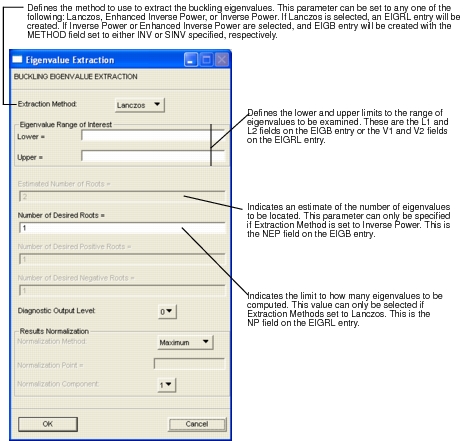
Parameter Name | Description |
Number of Desired Positive Roots | Indicates the limit to how many positive eigenvalues to be computed. This value can only be selected if Extraction Method is set to Inverse Power or Enhanced Inverse Power. This is the NDP field on the EIGB entry. |
Number of Desired Negative Roots | Indicates the limit to how many negative eigenvalues to be computed. This value cannot be selected if Extraction Method is set to Inverse Power or Enhanced Inverse Power. This is the NDN field on the EIGB entry. |
Diagnostic Output Level | Defines the level of desired output. This can take any integer value in the range of 0 through 3. This parameter can only be specified if Extraction Method is set to Lanczos. This is the MSGLVL field on the EIGRL Bulk Data entry. |
Normalization Method | Indicates what type of eigenvalue normalization is to be done. This parameter can take one of two settings: Maximum or Point. This parameter cannot be specified if Extraction Method is set to Lanczos. This is the NORM field on the EIGB entry. |
Normalization Point | Defines the point to be used in the normalization. This can only be selected if Normalization Method is set to Point. This parameter cannot be specified if Extraction Method is set to Lanczos. This is the G field on the EIGB entry. |
Normalization Component | Defines the degree-of-freedom component at the Normalization Point to be used. This, too, can only be selected if Normalization Method is set to Point. This parameter cannot be specified if Extraction Method is set to Lanczos. This is the C field on the EIGB entry. |
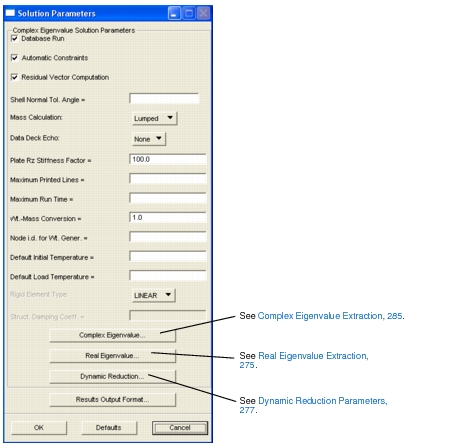
Database Run | Formulation | SOL |
On | Direct | 107 |
On | Modal | 110 |
Off | Direct | 28 |
Off | Modal | 29 |
Parameter Name | Description |
Automatic Constraints | Indicates that an AUTOSPC entry is requested, so that MD Nastran will constrain model singularities. |
Residual Vector Computation | The Residual Vector Computation toggle writes RESVEC=YES or RESVEC=NO to the Case Control. This calculates residual vectors due to applied loads. The default is to calculate residual vectors. |
Shell Normal Tolerance Angle | Indicates that MD Nastran will define grid point normals for a Faceted Shell Surface based on the Tolerance Angle. This data appears on a PARAM, SNORM entry. |
Mass Calculation | Defines how the mass matrix is to be treated within MD Nastran. This controls the setting of the COUPMASS parameter. This parameter can be set to either Coupled or Lumped. If set to Coupled, COUPMASS will be set to +1, otherwise, it will be set to -1. |
Data Deck Echo | Indicates how the data file entry images are to be printed in the MD Nastran print file. This controls the setting used for the ECHO Case Control command. This parameter can have one of three settings: Sorted, Unsorted, or None. |
Plate Rz Stiffness Factor | Defines the in plane stiffness factor to be applied to shell elements. This defines the K6ROT parameter. This is an alternate method to suppress the grid point singularities and is intended primarily for geometric nonlinear analysis. |
Maximum Printed Lines | Limits the size of the MD Nastran print file that will be generated. This defines the setting of the MAXLINES Case Control command. |
Maximum Run Time | Limits the amount of CPU time expressed in CPU minutes that can be used by this run. This is used to prevent runaway jobs. This defines the setting of the TIME Executive Control statement. |
Wt-Mass Conversion | Defines the conversion factor between weight and mass measures. This defines the setting of the WTMASS parameter. |
Node ID for Wt. Gener. | Indicates the node ID that is to be used for the Grid Point Weight Generator. This is the GRDPNT parameter. |
Default Inital Temperature | Specify the initial temperature. |
Default Load Temperature | Specify load temperature. |
Rigid Element Type | There is one rigid element type, Linear. |
Struct. Damping Coeff. | Defines a global damping coefficient to applied. This defines the G parameter (e.g., PARAM, G, value). |
Brings up the Complex Eigenvalue Extraction form for defining the complex eigenvalue extraction controls. | |
Brings up the Real Eigenvalue Extraction form for defining the real eigenvalue extraction controls. | |
Brings up the Dynamic Reduction Parameters form for defining the dynamic reduction controls. | |
Results Output Format | On the Results Output Format form you choose which output formats you want to use with your solution type. For more details, please see Results Output Format, 340. |
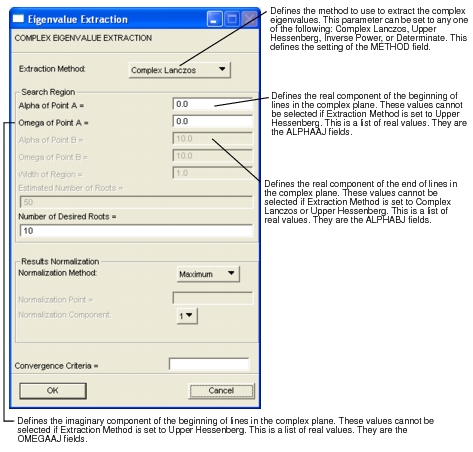
Parameter Name | Description |
Omega of B Points | Defines the imaginary component of the end of lines in the complex plane. These values cannot be selected if Extraction Method is set to Complex Lanczos or Upper Hessenberg. This is a list of real values. They are the OMEGABJ fields. |
Width of Regions | Defines the width of the region in the complex plane. This value cannot be selected if Extraction Method is set to Complex Lanczos or Upper Hessenberg. This is a list of real values. They are the LJ fields. |
Estimated Number of Roots | Indicates an estimate of the number of eigenvalues to be located within the specified region. This value cannot be selected if Extraction Method is set to Complex Lanczos or Upper Hessenberg. This is a list of integer values. They are the NEJ fields. |
Number of Desired Roots | Indicates the limit to how many eigenvalues to be computed within the specified region. This value cannot be selected if Extraction Method is set to Complex Lanczos or Upper Hessenberg. This is a list of integer values. They are the NDJ fields. |
Normalization Method | Indicates what type of eigenvalue normalization is to be done. This parameter can take one of two settings: Maximum or Point. This is the NORM field on the EIGC entry. |
Normalization Point | Defines the point to be used in the normalization. This is the G field on the EIGC Bulk Data entry. |
Normalization Component | Defines the degree-of-freedom component at the Normalization Point to be used. This can only be selected if Extraction Method is set to Inverse Power or Determinate. This is the C field on the EIGC Bulk Data entry. |
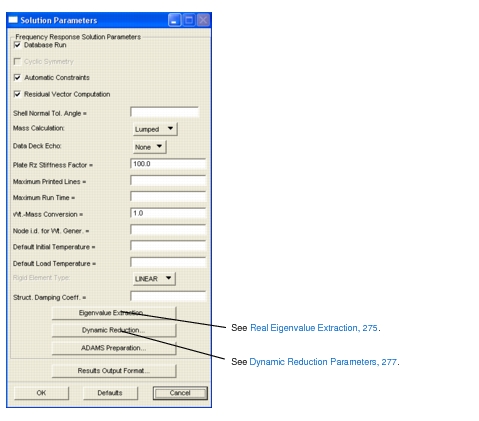
Database Run | Formulation | Cyclic Symmetry | SOL |
On | Direct | Off | 108 |
On | Direct | On | 118 |
On | Modal | -- | 111 |
Off | Direct | -- | 26 |
Off | Modal | -- | 30 |
Parameter Name | Description |
Cyclic Symmetry | Indicates that this model is a sector of a cyclically repeating part, and the appropriate flags will be set. This can only be set if Database Run is selected and Formulation is set to Direct (SOL 118). |
Automatic Constraints | Indicates that an AUTOSPC entry is requested, so that MD Nastran will constrain model singularities. |
Residual Vector Computation | The Residual Vector Computation toggle writes RESVEC=YES or RESVEC=NO to the Case Control. This calculates residual vectors due to applied loads. The default is to calculate residual vectors. |
Shell Normal Tolerance Angle | Indicates that MD Nastran will define grid point normals for a Faceted Shell Surface based on the Tolerance Angle. This data appears on a PARAM, SNORM entry. |
Mass Calculation | Defines how the mass matrix is to be treated within MD Nastran. This controls the setting of the COUPMASS parameter. This parameter can be set to either Coupled or Lumped. If set to Coupled, COUPMASS will be set to +1, otherwise, it will be set to -1. |
Data Deck Echo | Indicates how the data file entry images are to be printed in the MD Nastran print file. This controls the setting used for the ECHO Case Control command. This parameter can have one of three settings: Sorted, Unsorted, or None. |
Plate Rz Stiffness Factor | Defines the in plane stiffness factor to be applied to shell elements. This defines the K6ROT parameter. This is an alternate method to suppress the grid point singularities and is intended primarily for geometric nonlinear analysis. |
Maximum Printed Lines | Limits the size of the MD Nastran print file that will be generated. This defines the setting of the MAXLINES Case Control command. |
Maximum Run Time | Limits the amount of CPU time expressed in CPU minutes that can be used by this run. This is used to prevent runaway jobs. This defines the setting of the TIME Executive Control statement. |
Wt-Mass Conversion | Defines the conversion factor between weight and mass measures. This defines the setting of the WTMASS parameter. |
Node ID for Wt. Gener. | Indicates the node ID that is to be used for the Grid Point Weight Generator. This is the GRDPNT parameter. |
Default Inital Temperature | Specify the initial temperature. |
Default Load Temperature | Specify load temperature. |
Rigid Element Type | There is one rigid element type, Linear. |
Struct. Damping Coeff. | Defines a global damping coefficient to applied. This defines the G parameter (e.g., PARAM, G, value). |
Calls up the Real Eigenvalue Extraction form that is used to define the eigenvalue extraction controls. These parameters can only be specified if Formulation is set to Modal. | |
Calls up another form that is used to define the dynamic reduction controls. These parameters can only be specified if Formulation is set to Modal. | |
Results Output Format | On the Results Output Format form you choose which output formats you want to use with your solution type. For more details, please see Results Output Format, 340. |
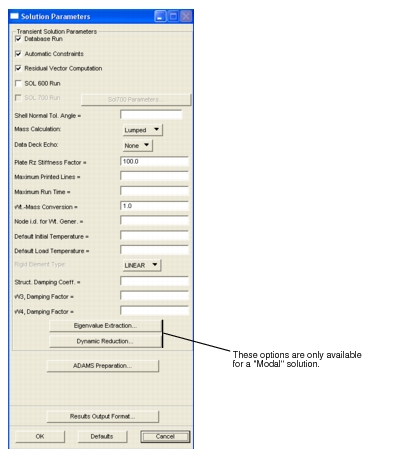
Database Run | Formulation | SOL |
On | Direct | 109 |
On | Modal | 112 |
Off | Direct | 27 |
Off | Modal | 31 |
Parameter Name | Description |
Automatic Constraints | Indicates that an AUTOSPC entry is requested, so that MD Nastran will constrain model singularities. |
Residual Vector Computation | The Residual Vector Computation toggle writes RESVEC=YES or RESVEC=NO to the Case Control. This calculates residual vectors due to applied loads. The default is to calculate residual vectors. |
SOL 600 Run | Select this to perform a SOL 600 analysis. |
SOL 700 Run | Select this to perform a SOL 700 analysis. To do this is necessary to use the Direct method. |
Shell Normal Tolerance Angle | Indicates that MD Nastran will define grid point normals for a Faceted Shell Surface based on the Tolerance Angle. This data appears on a PARAM, SNORM entry. |
Mass Calculation | Defines how the mass matrix will be treated within MD Nastran. This controls the setting of the COUPMASS parameter. This parameter can be set to either Coupled or Lumped. If set to Coupled, COUPMASS will be set to +1, otherwise, it will be set to -1. |
Data Deck Echo | Indicates how the data file entry images are to be printed in the MD Nastran print file. This controls the setting used for the ECHO Case Control command. This parameter can have one of three settings: Sorted, Unsorted, or None. |
Plate Rz Stiffness Factor | Defines the in plane stiffness factor to be applied to shell elements. This defines the K6ROT parameter. This is an alternate method to suppress the grid point singularities and is intended primarily for geometric nonlinear analysis. |
Maximum Printed Lines | Limits the size of the MD Nastran print file that will be generated. This defines the setting of the MAXLINES Case Control command. |
Maximum Run Time | Limits the amount of CPU time expressed in CPU minutes that can be used by this run. This is used to prevent runaway jobs. This defines the setting of the TIME Executive Control statement. |
Wt-Mass Conversion | Defines the conversion factor between weight and mass measures. This defines the setting of the WTMASS parameter. |
Node ID for Wt. Gener. | Indicates the node ID that is to be used for the Grid Point Weight Generator. This is the GRDPNT parameter. |
Default Inital Temperature | Specify the initial temperature. |
Default Load Temperature | Specify load temperature. |
Rigid Element Type | There is one rigid element type, Linear. |
Struct. Damping Coeff. | Defines a global damping coefficient to applied. This defines the G parameter (e.g., PARAM, G, value.) |
W3, Damping Factor W4, Damping Factor1 | Defines W3 and W4 parameters. These parameters alter the damping characteristics of the model. |
Calls up the Real Eigenvalue Extraction form that is used to define the eigenvalue extraction controls. These parameters can only be specified if Formulation is set to Modal. | |
Calls up the Dynamic Reduction Parameters form that is used to define the dynamic reduction controls. These parameters can only be specified if Formulation is set to Modal. | |
Results Output Format | On the Results Output Format form you choose which output formats you want to use with your solution type. For more details, please see Results Output Format, 340. |
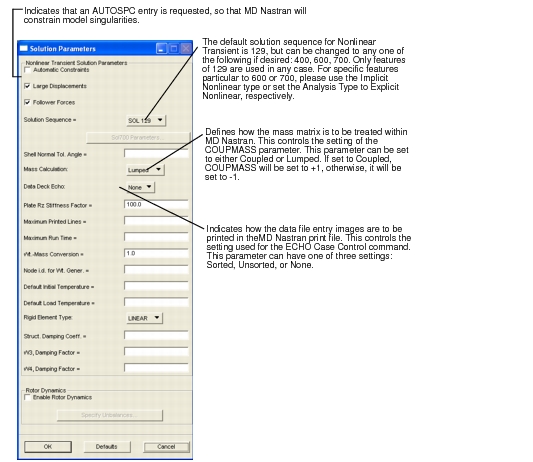
Parameter Name | Description |
Plate Rz Stiffness Factor | Defines the in plane stiffness factor to be applied to shell elements. This defines the K6ROT parameter. This is an alternate method to suppress the grid point singularities and is intended primarily for geometric nonlinear analysis. |
Maximum Printed Lines | Limits the size of the MD Nastran print file that will be generated. This defines the setting of the MAXLINES Case Control command. |
Maximum Run Time | Limits the amount of CPU time expressed in CPU minutes that can be used by this run. This is used to prevent runaway jobs. This defines the setting of the TIME Executive Control statement. |
Wt-Mass Conversion | Defines the conversion factor between weight and mass measures. This defines the setting of the WTMASS parameter. |
Node ID for Wt. Gener. | Indicates the node ID that is to be used for the Grid Point Weight Generator. This is the GRDPNT parameter. |
Struct. Damping Coeff. | Defines a global damping coefficient to applied. This defines the G parameter (e.g., PARAM, G, value.) |
W3, Damping Factor W4, Damping Factor | Define W3 and W4 parameters. These parameters alter the damping characteristics of the model. |
Results Output Format | On the Results Output Format form you choose which output formats you want to use with your solution type. For more details, please see Results Output Format, 340. |
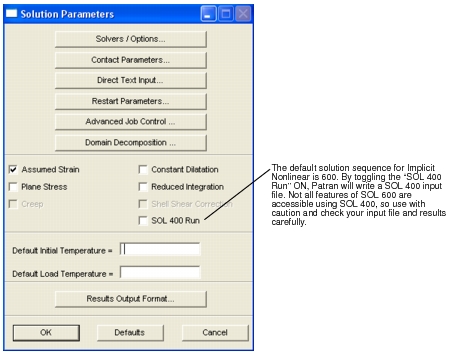
Solver / Options... | |
Contact Parameters... | |
Direct Text Input... | This subform is used to directly enter entries in the File Management, Executive Control, Case Control, and Bulk Data sections of the MD Nastran input file. See Direct Text Input, 266. |
Restart Parameters... | |
Advanced Job Control... | |
Domain Decomposition... | |
Assumed Strain | For SOL 600, if ON, (default is ON), places the MARCASUM parameter into the input file. This forces all elements that can deal with assumed strain to use this formulation. This improves the bending behavior of Marc elements 3, 7, and 11. For SOL 400, the NLMOPTS entry is written with the ASSUM option. Again, this is a global setting and forces all elements that can use this formulation to adopt it. |
Constant Dilatation | If ON, (default is OFF), places the parameter into the input file. This will force all elements that can deal with constant dilatation (for nearly incompressible analysis) to use this formulation. This affects Marc element types 7, 10, 11, 19, and 20 only and recommended for elastic-plastic and creep analysis. (SOL 600 only) |
Plane Stress | Replaces plane strain elements with plane stress elements. (SOL 600 only) |
Reduced Integration | Specifies that a lower number of element integration points be used to integrate exactly. (SOL 600 only) |
Creep | For SOL 400, writes the NLMOPTS entry with the CREEP option defaults for creep analysis. |
Shell Shear Correction | For SOL 400 (only), forces all shell elements using nonlinear formulations to use the shear correction. This writes the NLMOPTS entry with the TSHEAR option. |
SOL 400 Run | Use this to select a SOL 400 simulation, instead of a SOL 600 simulation. |
Default Initial or Load Temperature | For SOL 400 allows for specification of a general initial temperature and a general loading temperature. TEMPD entries are written for both with Case Control TEMPERATURE(INITIAL) and TEMPERATURE(LOAD) entries calling out the corresponding TEMPD entries in the bulk data. |
Results Output Format... | On the Results Output Format form you choose which output formats you want to use with your solution type. For more details, please see Results Output Format, 340. |
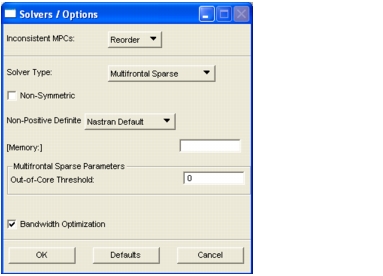
Inconsistent MPCs | There are three choices for dealing with problem MPCs, 1) Reorder (reorder the DOFs that are used to define the problem MPCs), 2) Continue (continue the analysis with no changes to the MPCs DOFs), or 3) Stop (stop the analysis). |
Solver Type | Can be set to Direct Profile, Iterative Sparse, Direct Sparse, Hardware Sparse, Multifrontal Sparse (default) or External Sparse. For MD Nastran 2010 or higher, Pardizo Direct Sparse and MUMPS Parallel Direct solvers are also supported. |
Non-Symmetric | Specifies non-symmetric solution for Solver Types: Direct Profile, Multifrontal Sparse,or Pardizo Direct Sparse. |
Non-Positive Definite | Turn this menu to ON to specify non-positive definite option. Valid for all solver types. Non Positive Definite is ON by default fo SOL 600. It is recommended to leave this menu set to Nastran Default. You may deselect this option by setting to OFF. |
Memory | Defines the amount of work space in words. This can be left blank and the translator will automatically determine this based on model size. |
Multifrontal Sparse Parameters | |
• Out-of-Core Threshold | For Hardware and Multifrontal Sparse solvers only. Default is 100. Represents the number of real*4 words in millions of words. Only for SGI computers running the IRIX operating system. |
Bandwidth Optimization | Turns on the optimize option for the Direct Profile or Multifrontal Sparse solvers and uses the Sloan algorithm. Other solvers have their own optimizer and use it by default. |
Number of Processes | Multiple treads can be specified for Pardiso(11) and Multifrontal (8) sparse solvers. The subsequent MD Nastran job is submitted with the MRTHREAD parameter set accordingly. Multiple processors can be specified for MUMPS(12) solver. The subsequent MD Nastran job is submitted with the MUMPSOLV parameter set accordingly. For DDM, by default the number of processes is set to the number of domains automatically. It can be manually changed if necessary. |
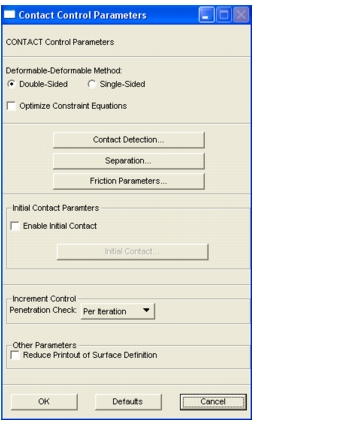
Deformable-Deformable Method | In Double-Sided method, for each contact body pair, nodes of both bodies will be checked for contact. In Single-Sided method, for each contact body pair, only nodes of the lower-numbered body will be checked for contact. Results are dependent upon the order in which contact bodies are defined. |
Optimize Constraint Equations | Use this to decrease the bandwidth of the model. |
Contact Detection... | |
Separation... | |
Friction Parameters... | |
Enable Initial Contact | Click on checkbox to activate the capability for control of initial contact. The initial contact is for creating an MD Nastran entry BCTABLE with ID = 0 to be used for increment 0. For SOL 600, this causes rigid contact bodies to be moved so they just touch adjacent flexible contact bodies. For SOL 101 and 400, a BCTABLE is used with ID = 0, which causes rigid contact bodies to be moved, as for SOL 600, and/or adjusting the coordinates of all active nodes on the surface of all deformable BCBODYs to remove any prestressed condition. |
Initial Contact... | |
Penetration Check | This controls contact penetration checking, sometimes referred to as the increment splitting option. Available options are: At End of Increment, Per Iteration (default), Suppressed (Fixed), Suppressed (Adaptive). At End of Increment means penetration is checked at the end of a load increment. Per Iteration means that penetration is checked at the end of every iteration within an increment. If penetration is detected, increments are split. Suppress is to suppress this feature for Fixed and Adaptive load stepping types. |
Reduce Printout of Surface Definition | This controls reduction of printout of surface definition. |
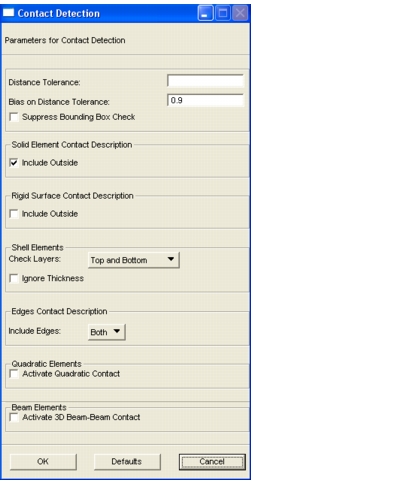
Distance Tolerance | Distance below which a node is considered touching a body (error). Leave the box blank to have MSC.Marc calculate the tolerance as the smaller of 1/20 element edge length or 1/4 shell thickness. |
Bias on Distance Tolerance | Contact tolerance BIAS factor. The value should be within the range of zero to one. Models with shell elements seem to be sensitive to this parameter. You may need to experiment with this value if you have shell element models that will not converge. The SOL 600 default is 0.9. |
Suppress Bounding Box Check | Turn ON this button if you want to suppress bounding box checking. This might eliminate penetration, but slows down the solution. |
Include Outside (Solid Element) | When detecting contact of elements (beam/bar, shell, solid elements) use this to include contact of the outside of the elements. For details refer to the BCPARA entry (contact parameters) of the MD Nastran QRG. The entries that are used for the BCPARA entry are ITOPBM (beam/bar), ITOPSH (plate/shell), and ITOPSD (solid). |
Include Outside (Rigid Surface) | When detecting contact of rigid surfaces use this to include contact of the edges of the surfaces. For details refer to the BCPARA entry (contact parameters) of the MD Nastran QRG. The entries that are used for the BCPARA entry are ITOPBM (beam/bar), ITOPSH (plate/shell), and ITOPSD (solid). |
Check Layers | For contact bodies composed of shell elements, this option menu chooses the layers to be checked. Available options are: Top and Bottom, Top Only, Bottom Only. Check Layers and Ignore Thickness combination enters the appropriate flag in the 10th field of the 2nd data block. |
Ignore Thickness | Turn this button ON to ignore shell thickness. Check Layers and Ignore Thickness combination enters the appropriate flag in the 10th field of the 2nd data block. |
Include Edges | Use this to detect contact of edges. There are three options, Beam/Bar, Free and Hard Shell, or Both. For details refer to the BCPARA entry (contact parameters) of the MD Nastran QRG. The entries that are used for the BCPARA entry are ITOPBM (beam/bar), ITOPSH (plate/shell), and ITOPSD (solid). |
Activate Quadratic Contact | Use this to detect the contact of the edges of quadratic elements (midside nodes). |
Activate 3D Beam-Beam Contact | Turn this button ON to activate 3D beam-beam contact. Activate 3D Beam-Beam Contact enters a one(1) in the 13th field of the 2nd data block. This creates the MD Nastran Bulk Data entry BCPARA, and uses the entry BEAMP. |
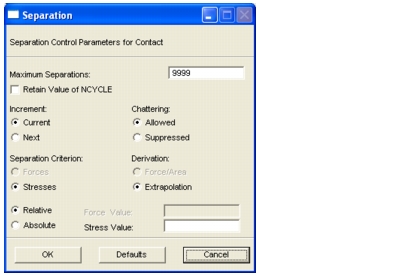
Maximum Separations | Maximum number of separations allowed in each increment. Maximum Separations is entered in the 6th field of the 2nd data block. Default is 9999. |
Retain Value on NCYCLE | Turn ON this button if you do not want to reset NCYCLE to zero when separation occurs. This speeds up the solution, but might result in instabilities. You can not set this and Suppress Bounding Box simultaneously. Retain Value of NCYCLE enters a three(3) in field 8 of the 2nd data block. |
Increment | Specifies whether chattering is allowed or not. Increment and Chattering enters the appropriate flag in the 9th field of the 2nd data block. |
Chattering | Specifies the separation criterion (forces or stresses) and the critical value at which the separation will take place. Increment and Chattering enters the appropriate flag in the 9th field of the 2nd data block. |
Separation Criterion | Specifies in which increment (current or next) the separation is allowed to occur. Separation Criterion enters a one(1) in the 12th field of the 2nd data block if separation is based on stresses. |
Force Value Stress Value | Force/Stress Value is placed in the 5th field of the 3rd data block. |
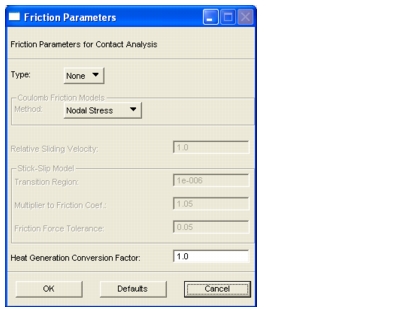
Friction Type | Available options for friction Type are: None (default), Shear (for metal forming), Coulomb (for normal contact), Shear for Rolling, Coulomb for Rolling, Stick-Slip, Bilinear Shear, and Bilinear Coulomb. The MD Nastran entry BCPARA is written to the .bdf file, with FTYPE used. Type and Method: places 0, 1, 2, 3, 4, or 5 in the 4th field of the 2nd data block depending on fiction type, and places a 0 or 1 in the 5th field of the 2rd data block for friction based on nodal forces or nodal stresses, respectively for Coulomb fiction. Stick-Slip is a Coulomb type friction. |
Method | For Coulomb type of friction models (options 2, 4, and 5 above), there are 2 methods for computing friction: Nodal Stress, Nodal Force (default). Type and Method: places 0, 1, 2, 3, 4, or 5 in the 4th field of the 2nd data block depending on fiction type, and places a 0 or 1 in the 5th field of the 2rd data block for friction based on nodal forces or nodal stresses, respectively for Coulomb fiction. |
Relative Sliding Velocity | Critical value for sliding velocity below which surfaces will be simulated as sticking. Relative Sliding Velocity is placed in the 1st field of the 3rd data block for all friction models except Stick-Slip. |
Transition Region | Slip-to-Stick transition region. Transition Region is placed in the 1st field of the 3rd data block for Stick-Slip model. |
Multiplier to Friction Coefficient | Friction coefficient multiplier. Multiplier to Friction Coefficient and Friction Force Tolerance are placed in the 7th and 8th field of the 3rd data block respectively for the Stick-Slip friction model. |
Friction Force Tolerance | Multiplier to Friction Coefficient and Friction Force Tolerance are placed in the 7th and 8th field of the 3rd data block respectively for the Stick-Slip friction model. |
Heat Generation Conversion Factor | A factor related to how much heat is generated by the friction process. |
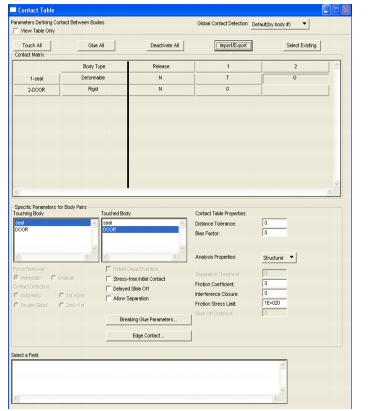
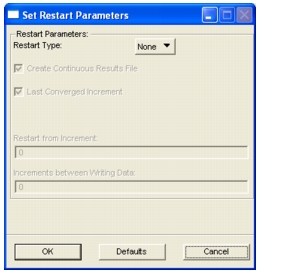
Restart Type | You can Write restart data, Read restart data and Read and Write restart data. The default is None for no restart data. |
Create Continuous Results File | If when restarting a job, you wish the results form the previous run to be copied into the new POST file, then turn this ON. This will place the or options before the POST option in the input file. Otherwise they are placed after the option which flags MSC.Marc not to copy the results to the new POST file. If you turn this ON, you must have a restarname.t16 and/or restartname.t19 file in your local directory or the MSC.Marc analysis will fail. |
Last Converged Increment | Writes a instead of a option. ON by default. |
Reauto | OFF by default. This places a EAUTO option in the input file. Any additional data needed for the option are extracted from the first Load Step information for the restart job. Only if the Restart Type is set to Read or Read and Write is the written or the toggle visible to the user. |
Restart from Increment | Defines the increment to be read from the file specified in the Select Restart File form. This is entered in the 3rd data field on the 2nd card of the option. It is only requested when Restart Type is set to Read or Read and Write. The last increment on the restart file is used for the option when Last Converged Increment is ON. |
Increments Between Writing | Defines the number of increments between writing data to the restart file. This is entered in the 2nd data field on the 2nd card of the option. It is only requested when Restart Type is set to Write or Read and Write. When Last Converted Increment is ON, this is the 4th field of the 2nd data block of the option. |
Select Restart File... | This brings up a file browser to select the restart file when the Restart Type is set to Read or Read and Write. This file is specified on the command line for invoking the MSC.Marc solver using the -r option. |
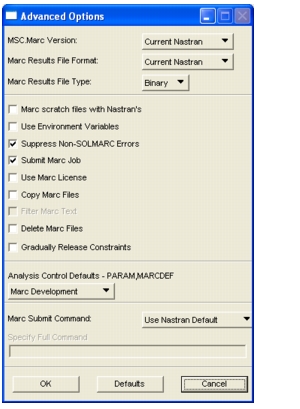
Marc Version | Specifies the version of MSC.Marc to run the analysis. |
Marc Results File Format | Specifies the file format for the output from the analysis. |
Marc Results File Type | Defines the binary output and/or text format of output from the analysis. Binary is recommended since .t16 files are linarily compatible across platforms and take up less space. |
Marc scratch files w/ Nastran’s | |
Use Environment Variables | Use to enable the use of environment variables. |
Suppress Non-SOLMARC Errors | Suppress errors that are not SOL 600 errors. |
Submit Marc Job | Submit SOL 600 jobs to Marc. |
Use Marc License | Use this to search for, then use Marc licenses. |
Copy Marc Files | Make copies of Marc files; for example copy .t16 file. |
Filter Marc Text | |
Delete Marc Files | Delete Marc files after the corresponding Patran files are created. |
Gradually Release Constraints | |
Analysis Control Defaults | Creates the Nastran Bulk Data entry PARAM, MARCDEF. Its three values are Nastran Development (recommended by Nastran development; Marc SHELL_SECT parameter is set to 11), Marc-Mentat (current Marc standard), Marc Development (recommended by both Marc and Nastran development). |
Marc Submit Command | Locates the submit command to run the MSC.Marc analysis (optional). For Specify Full Command its list box will be un-ghosted. |
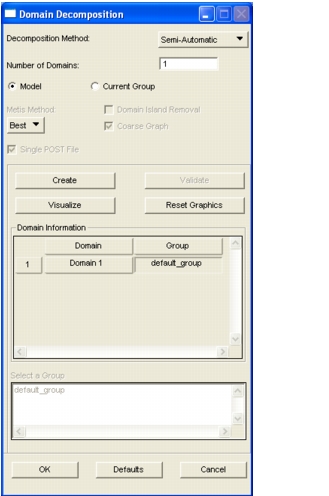
Decomposition Method | Set this to Automatic if you wish MD Nastran to automatically create the domains during analysis run time. Set to Semi-Automatic if you wish to have MSC.Patran automatically break the model into domains which can be visualized before submittal. Set to Manual to have full control over the domains. This requires the creation of the groups before they can be selected here in this form and associated to a domain. |
Number of Domains | This determines how many domains are to be created. When you change this number and press the Enter or Return key, the spread sheet updates with this number of rows. The default is 1. This corresponds to the number of CPUs desired to run the job. For the Automatic method, this is the only input that is required and the spreadsheet is not visible. |
Model or Current Group | This is for choosing a part of the model to decompose for parallel processing: Model -- decompose all of the model, Current Group -- decompose just the current group. This choice must be consistent with what part of the model is specified for analysis (Analysis: Analyze / Entire Model or Selected Group). This is only active if Decomposition Method is set to Automatic or Semi-Automatic. |
Metis Method | There are three Methods that can be used to partition the Model or Current Group into Domains. They are, 1) Nodal Position, 2) Element Topology, or 3) Best (a procedure that accounts for the best of the nodal, element, or vector type algorithms). This method can only be used if Decomposition Method is set to Automatic. |
Domain Island Removal | Using this option causes some parts of disjoint domains (domain islands) to be combined with adjacent domains. This can only be used if Decomposition Method is set to Automatic. |
Coarse Graph | Using this option sometimes produces domain islands (disjoint domains). This option (the default) is recommended to reduce the time to decompose the initial global domain. Use this only if there is a definite need for a better decomposition. This can only be used if Decomposition Method is set to Automatic. |
Single POST File | If more than one CPU processor is used to solve the problem, the seperate/multiple results files can be compiled into a single file for postprocessing using Single POST File. |
Create | Click Create to create Domain Information spreadsheet rows. After doing this the number of rows will equal the value of Number of Domains in the form. If Decomposition Method is set to Manual, the previously created group names will be selectable in Select a Group window at the bottom. |
Visualize | This is used to display groups. Select a group name for the heading Domain Information under Group. Click Visualize to display just that group. This can be done for some or all of the groups. |
Reset Graphics | Click Reset Graphics to reset the viewport graphics. |
Validate | This is for validating (checking) that the domains are not disjoint. For two adjacent domains, the nodes at the interface of the domains must be in both domains. |
Domain Information | The window with the definition of each Domain. For a given Domain there is a corresponding unique Group name. |
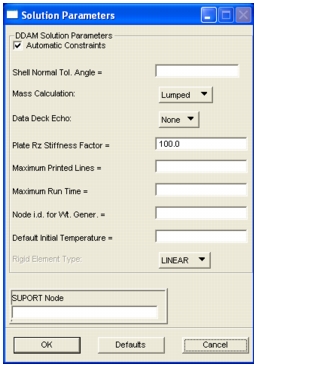
Automatic Constraints | Indicates that an AUTOSPC entry is requested. MD Nastran will automatically constrain model singularities. |
Shell Normal Tol. Angle | Indicates that MD Nastran will define grid point normals for a Faceted Shell Surface based on the Tolerance Angle. This data appears on a PARAM, SNORM entry. |
Mass Calculation | |
• Lumped | Defines how the mass matrix is to be treated within MD Nastran. This controls the setting of the COUPMASS parameter. This parameter can be set to either Coupled or Lumped. If set to Coupled, COUPMASS will be set to +1, otherwise, it will be set to -1. |
• Coupled | |
Data Deck Echo | |
• None | Indicates how the data file entry images are to be printed in the MD Nastran print file. This controls the setting used for the ECHO Case Control command. This parameter can have one of three settings: Sorted, Unsorted, or None. |
• Sorted | |
• Unsorted | |
Plate Rz Stiffness factor | Defines the in plane stiffness factor to be applied to shell elements. This defines the K6ROT parameter. This is an alternate method to suppress the grid point singularities and is intended primarily for geometric nonlinear analysis. |
Maximum Printed Lines | Limits the size of the MD Nastran print file that will be generated. This defines the setting of the MAXLINES Case Control command. |
Maximum Run Time | Limits the amount of CPU time expressed in CPU minutes that can be used by this run. This is used to prevent runaway jobs. This defines the setting of the TIME Executive Control statement. |
Wt-Mass Conversion | Defines the conversion factor between weight and mass measures. This defines the setting of the WTMASS parameter. |
Node id for Wt. Gener | Indicates the node ID that is to be used for the Grid Point Weight Generator. This is the GRDPNT parameter. |
Default Initial Temperature | Defines the Default Initial Temperature: TEMPD value for subcase entry TEMP(INITIAL) |
Default Load Temperature | Defines the Default Load Temperature: Sets the TEMPD value for the subcase entry TEMP(LOAD) subcase entry. |
SUPPORT Node | Selects the point you have chosen for your base input. Note that this is a required choice with no default, and that you can only pick one node. If multiple nodes are entered in the data box, only the first one is used. |
Results Output Format | On the Results Output Format form you choose which output formats you want to use with your solution type. For more details, please see Results Output Format, 340. |
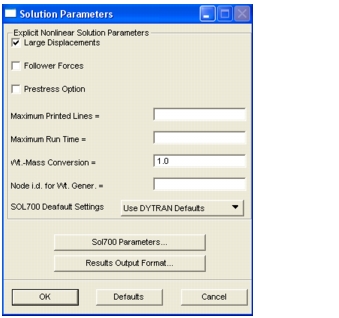
Parameter Name | Description |
Large Displacements | Use this to cause the large displacement formulation to be used. |
Follower Forces | Use this to cause the forces to move (translate and rotate) with the model. |
Prestress Option | Use this to cause the pre-stresses to be calculated. |
Maximum Printed Lines | Limits the size of the MD Nastran print file that will be generated. This defines the setting of the MAXLINES Case Control command. |
Maximum Run Time | Limits the amount of CPU time expressed in CPU minutes that can be used by this run. This is used to prevent runaway jobs. This defines the setting of the TIME Executive Control statement. |
Wt-Mass Conversion | Defines the conversion factor between weight and mass measures. This defines the setting of the WTMASS parameter. |
Node ID for Wt. Gener. | Indicates the node ID that is to be used for the Grid Point Weight Generator. This is the GRDPNT parameter. |
SOL 700 Default Settings | Either Dytran or Ls-Dyna default settings can be used. |
Displays the Sol700 Parameters and Extra Data form that is used for specifing parameter values for such things as execution control, dynamic relaxation (entry DAMPGBL), general parameters, contact, and Eulerian parameters. See Sol700 Parameters Subform, 319 | |
• Resultts Output Format... | Use this to specify the types of files that are to be written for the SOL 700 analysis. For example, XDB (jobname.xdb) and Print (jobname.f06).See Results Output Format, 340 |
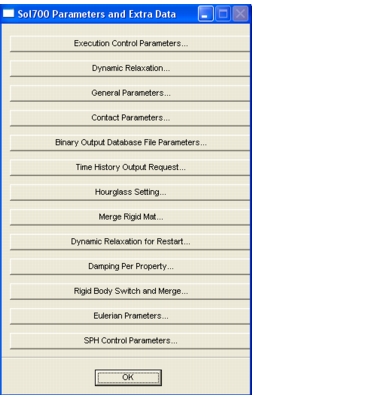
Form | Parameters |
Execution Control Parameters... | DYSTATIC, DYBLDTIM, DYINISTEP, DYTSTEPERODE, DYMINSTEP, DYMAXSTEP, DYSTEPFCTL, DYTERMNENDMAS, DYTSTEPDT2MS |
Dynamic Relaxation... | This is for specifying the entries for the DAMPGBL Bulk Data entry. This is for defining parameter values for static analysis using dynamic relaxation for SOL 700 only. |
General Parameters... | DYLDKND, DYCOWPRD, DYCOWPRP, DYBULKL, DYHRGIHQ, DYRGQH, DYENERGYHGEN, DYSHELLFORM, DYSHTHICK, DYSHNIP |
Contact Parameters... | DYCONSLSFAC, DYCONRWPNAL, DYCONPENOPT, DYCONTHKCHG, DYCONENMASS, DYCONECDT, DYCONIGNORE, DYCONSKIPTWG |
Binary Output Database File Parameters... | DYBEAMIP, DYMAXINT, DYNEIPS, DYNINTSL, DYNEIPH, DYSTRFLG, DYSIGFLG, DYEPSFLG, DYRLTFLG, DYENGFLG, DYCMPFLG, DYIEVERP, DYDCOMP, DYSHGE, DYSTSSZ, DYN3THDT |
Time History Output Request... | This is for specifying the type of output file (Binary, ASCII, Both), and the Output Time Interval. |
Hourglass Setting... | |
Merge Rigid Mat... | |
Dynamic Relaxation for Restart... | |
Damping Per Property... | |
Rigid Body Switch and Merge... | |
Eulerian Parameters... | |
SPH Control Parameters... |
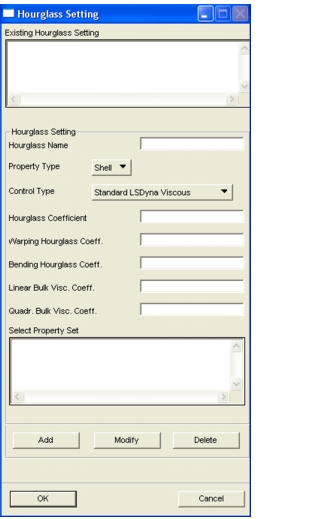
Form | Parameters |
Existing Hourglass Setting | List of previously created hourglass settings. |
Hourglass Name | Specify the name. |
Property Type | Specify either a Shell (2D) or Solid (3D) element type. |
Control Type | Choose one of several types of controlling the hourglass effects. The choices are: 1) Standard LSDyna Viscous (Property Type = Shell or Solid), 2) Flanagan-Belytschko Viscous (Property Type = Shell or Solid), 3) Flan-Bely. Visc. + Vol. Integ. (exact volume integration for solid elements) (Property Type = Solid), 4) Flanagan-Belytschko Stiffness (Property Type = Shell or Solid), 5) Flan-Bely. Stiff. + Vol. Integ. (exact volume integration for solid elements) (Property Type = Solid), 6) Flanagan-Bindeman Stiffness (Property Type = Solid), 7) Fully Integrated Shell (Property Type = Shell). These entries are defined on the HGSUPPR Bulk Data entry in the MD Nastran Quick Reference Guide. |
Hourglass Coefficient | This entry is defined on the HGSUPPR Bulk Data entry in the MD Nastran Quick Reference Guide. |
Warping Hourglass Coeff. | This entry is defined on the HGSUPPR Bulk Data entry in the MD Nastran Quick Reference Guide. |
Bending Hourglass Coeff. | This entry is defined on the HGSUPPR Bulk Data entry in the MD Nastran Quick Reference Guide. |
Linear Bulk Visc. Coeff. | This entry is defined on the HGSUPPR Bulk Data entry in the MD Nastran Quick Reference Guide. |
Quadr. Bulk Visc. Coeff. | This entry is defined on the HGSUPPR Bulk Data entry in the MD Nastran Quick Reference Guide. |
Select Property Set | Select a previously created element property. For example, Properties > Create > 2D > Shell > Options: Explicit PSHELL1 > Input Properties... > Shell Formulations > HUGHES. |
Add | Click Add after input all necessary data into the Hourglass Setting form to create an Existing Hourglass Setting. |
Modify | Click Modify after input all changed data into the Hourglass Setting form to update an Existing Hourglass Setting. You must first select the particular Existing Hourglass Setting. |
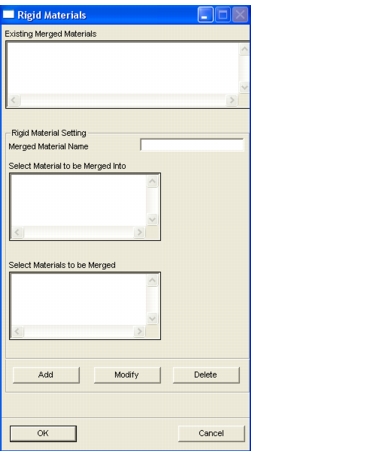
Form | Parameters |
Existing Merged Materials | List of previously merged MATRIG materials. MATRIG is an MD Nastran Bulk Data entry for defining rigid body properties. |
Merged Material Name | Specify the name of merged material to be created. |
Select Material to be Merged into | Specify the name of an MATRIG material to merge other MATRIG materials into. |
Select Materials to be Merged | Specify the names of MATRIG materials that are to be merged into the merged material whos name is specified under Merged Material Name. |
Add | Click Add after input all necessary data into the Rigid Materials form to create an Existing Merged Materials. |
Modify | Click Modify after input all changed data into the Rigid Materials form to update an Existing Merged Materials. You must first select the particular Existing Merged Materials. |
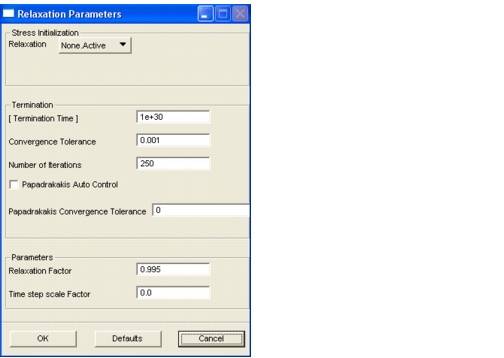
Form | Parameters |
Relaxation | Use this to not use (None Active) or use (Activated Relaxation) relaxation in performing the simulation. |
[Termination Time] | The time to stop the simulation. This is optional ([ ]). |
Convergence Tolerance | Specify convergence tolerance. |
Number of Iterations | Specify the maximum number of iterations. |
Papadrakakis Auto Control | Click the checkbox to specify that convergence control is to be automatic using the Papadrakakis method. |
Papadrakakis Convergence Tolerance | To use this it is necessary to not select Papadrakakis Auto Control. |
Relaxation Factor | Specify the value of the Relaxation Factor. |
Time step scale Factor | Specify the value of the Time step scale Factor. |
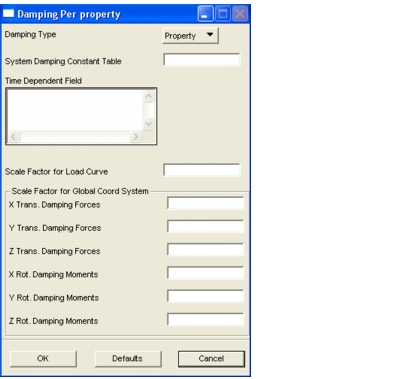
Form | Parameters |
Damping Type | Select either Property (use property) or Stiffness (use Rayleigh damping). |
System Damping Constant Table | Select a time dependent field under Time Dependent Field. This field will be multiplied by the Scalar Factor for Load Curve entry. The (X,Y,Z) Trans. Damping Forces and (X,Y,Z) Rot. Damping Moments entries (all of these form a 6 component load vector) are multiplied by the scaled time dependent field. |
Time Dependent Field | Select a Field, with it being entered into the System Damping Constant Table list box. For example, select the field named damping_vs_time under Time Dependent Field. For System Damping Constant Table f:damping_vs_time appears. |
Scale Factor for Load Curve | Specify the scale factor that will multiply the Time Dependent Field specified under System Damping Constant Table. |
X Trans. Damping Forces | Scale factor for X translation damping forces, in the global coordinate system directions. |
Y Trans. Damping Forces | Scale factor for Y translation damping forces, in the global coordinate system directions. |
Z Trans. Damping Forces | Scale factor for Z translation damping forces, in the global coordinate system directions. |
X Rot. Damping Moments | Scale factor for X rotation damping moments, in the global coordinate system directions. |
Y Rot. Damping Moments | Scale factor for Y rotation damping moments, in the global coordinate system directions. |
Z Rot. Damping Moments | Scale factor for Z rotation damping moments, in the global coordinate system directions. |
Rayleigh Damping Coeff. | Specify the scalar coefficient (β) that the global stiffness matrix is multiplied by to obtain the Rayleigh damping matrix. |
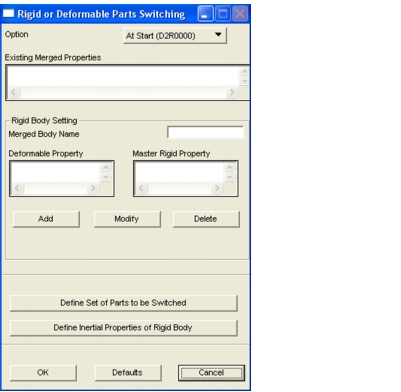
Form | Parameters |
Option | Only option is At Start (D2R0000). |
Existing Merged Properties | List of deformable body and rigid body properties that have already been merged. |
Merged Body Name | Specify the name of the Existing Merged Properties entry to be created. |
Deformable Property | Select an entry under Deformable Property |
Master Rigid Property | Select an entry under Master Rigid Property |
Add | Click Add to create an entry under Existing Merged Properties. |
Modify | Click Modify to save the changed selections under Deformable Property and Master Rigid Property to update an Existing Merged Properties. You must first select the particular Existing Merged Properties. |
Define Set of Parts to be Switched | |
Define Inertial Properties of Rigid Body |
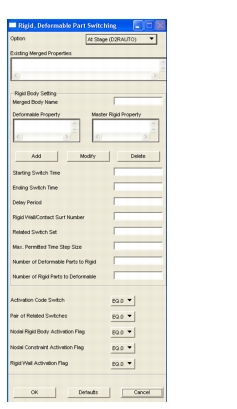
Form | Parameters |
Option | Only option is At Stage (D2RAUTO). |
Existing Merged Properties | List of deformable body and rigid body properties that have already been merged. |
Merged Body Name | Specify the name of the Existing Merged Properties entry to be created. |
Deformable Property | Select an entry under Deformable Property. |
Master Rigid Property | Select an entry under Master Rigid Property. For example, a 2D Shell Element Property created using an Isotropic (SOL 700) Rigid MATRIG material. |
Add | Click Add to create an entry under Existing Merged Properties. |
Modify | Click Modify to save the changed selections under Deformable Property and Master Rigid Property to update an Existing Merged Properties. You must first select the particular Existing Merged Properties. |
Starting Switch Time | Specify the time to switch the deformable and rigid properties. |
Ending Switch Time | Specify the time to terminate the switching of the deformable and rigid properties. |
Delay Period | Specify the time delay (τ) for switching. |
Rigid Wall/Contact Surf Number | Specify the surface numbers for rigid walls/surfaces that are to contact. |
Related Switch Set | |
Max. Permited Time Step Size | Specify the maximum time step. |
Number of Deformable Parts to Rigid | Specify the number of deformable parts that will be switched to rigid parts. |
Number of Rigid Parts to Deformable | Specify the number of rigid parts that will be switched to deformable parts. |
Activation Code Switch | Select one of the five flags, 1) EQ.0, 2) EQ.1, 3) EQ.2, 4) EQ.3, or 5) EQ.4. |
Pair of Related Switches | Select one of the three flags, 1) EQ.0, 2) EQ.1, 3) EQ.-1. |
Nodal Rigid Body Activation Flag | Select one of the three flags, 1) EQ.0, 2) EQ.1, 3) EQ.2. |
Nodal Constraint Activation Flag | Select one of the three flags, 1) EQ.0, 2) EQ.1, 3) EQ.2. |
Rigid Wall Activation Flag | Select one of the three flags, 1) EQ.0, 2) EQ.1, 3) EQ.2. |
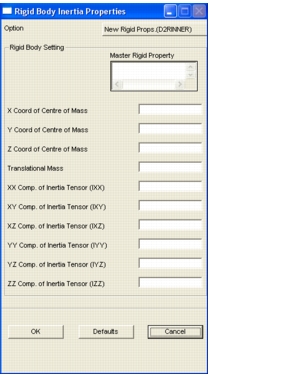
Form | Parameters |
Option | Only option is New Rigid Props. (D2RINNER). |
Master Rigid Property | Select a Master Rigid Property. For example, a 2D Shell Element Property created using an Isotropic (SOL 700) Rigid MATRIG material. |
X Coord of Center of Mass | X coordinate of center of mass. |
Y Coord of Center of Mass | Y coordinate of center of mass. |
Z Coord of Center of Mass | Z coordinate of center of mass. |
Translational Mass | Scalar mass value for translation, not rotation. |
XX Comp. of Inertia Tensor (IXX) | XX (1,1) component of inertia tensor matrix. |
XY Comp. of Inertia Tensor (IXY) | XY (1,2) component of inertia tensor matrix. |
XZComp. of Inertia Tensor (IXZ) | XZ (1,3) component of inertia tensor matrix. |
YY Comp. of Inertia Tensor (IYY) | YY (2,2) component of inertia tensor matrix. |
YZ Comp. of Inertia Tensor (IYZ) | YZ (2,3) component of inertia tensor matrix. |
ZZ Comp. of Inertia Tensor (IZZ) | ZZ (3,3) component of inertia tensor matrix. |
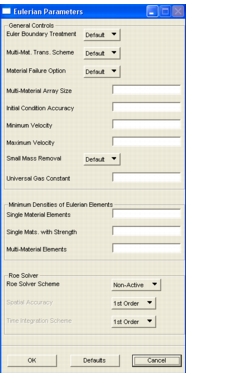
Form | Parameters |
Euler Boundary Treatment | There are three choices, 1) Default, 2) Extrapolate (extrapolate structural mesh pressure to Euler elements at solid/fluid boundary), or 3) Element (solid/fluid boundary Euler element pressure equals the structural element pressure at the solid/fluid boundary). |
Multi-Mat. Trans. Scheme | There are three choices, 1) Default (Impulse), 2) Average (face (surface) velocity is averaged simply), or 3) Impulse (face (surface) velocity is impulse weighted). |
Material Failure Option | There are three choices, 1) Default (No Fail), 2) Fail (activates transport of fail fraction and thereby keeps track of material that has failed), or 3) No Fail (failed Euler material can support shear stress again as soon as new material enters the Euler element). |
Multi-Material Array Size | The multi-material Eulerian elements use an overflow array to store their material data. This array can hold “Multi-Material Array Size” times the number of Eulerian elements. If more the 10% of the Eulerian elements have more than one material, the value of “Multi-Material Array Size” must be increased. |
Initial Condition Accuracy | A parameter value used to specify the accuracy of the initial conditions in Eulerian elements, when using the geometric shape definition. The parameter value is specified in the input file using PARAM, MICRO, value. |
Mimimum Velocity | A parameter value used to specify the minimum velocity. If a calculated velocity is less than this, it is set to zero (0). It is mainly used to eliminate harmless small values. The parameter value is specified in the input file using PARAM, VELCUT, value. |
Maximum Velocity | Specify the maximum velocity for Eulerian and Lagrangian meshes. Although it is not usually necessary to limit the velocity in Eulerian meshes, there are occasions in regions of near-vacuous flow where using this can be an advantage. The same thing applies to Lagrangian meshes, where there is contact. The parameter value is specified in the input file using PARAM, VELMAX, value, YES/NO. Default is 1.0e10, YES. See the next row for information on what YES/NO means. |
Small Mass Removal | Because very high velocities occur mostly in Eulerian elements with very small mass, the mass in these elements may need to be removed for the analysis to be stable. The above parameter (PARAM, VELMAX) is used to specify whether or not to eliminate small masses. YES = eliminate the mass for Eulerian elements for which the velocity is > the value of VELMAX. NO = do not eliminate the mass for Eulerian elements for which the velocity is > the value of VELMAX. Default = YES. |
Universal Gas Constant | Specify the value of the universal gas constant. The parameter value is specified in the input file using PARAM, UGASC, value. |
Single Material Elements | Specify the minimum density of single material Eulerian elements. For arbitrary Lagrange-Euler (ALE) coupling, Eulerian single material elements with strength cannot be used. |
Single Mats. with Strength | Specify the minimum density of single material Eulerian elements with strength. For arbitrary Lagrange-Euler (ALE) coupling, Eulerian single material elements with strength cannot be used. |
Multi-Material Elements | Specify the minimum density of multi-material Eulerian elements. |
Roe Solver Scheme | Specify whether or not to use the Roe solver. The Roe solver accounts for momentum exchange between Lagrange (structure) and Eulerian material. |
Spatial Accuracy | There are two schemes that can be used. They are, 1) 1st Order (left and right state variables are taken as the values the state variables have at the left- and the right-element center), or 2) 2nd Order (left- and right-state variable values at a face by including the left-left and the right-right element). |
Time Integration Scheme | There are two schemes that can be used. They are, 1) 1st Order, or 2) 2nd Order (three-stage time integration scheme). |
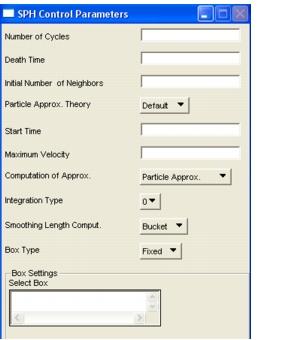
Form | Parameters |
Number of Cycles | Specify the number of cycles between particle sorting. |
Death Time | Specify the time when SPH calculations are to be stopped. |
Initial Number of Neighbors | Specify the initial number of neighbors per particle. This parameter is for specifying how much memory is to be allocated for arrays during initialization. If the value is positive, the memory will be dynamically allocated. If the value is negative, the memory allocation will be static (constant). During the calculation only the closest SPH elements will be considered as neighbors. Using this option can avoid memory allocation problems. |
Particle Approx. Theory | There are six theories to choose from, 1) Renormalization (approximation), 2) Symmetric (formulation), 3) Sym. Renormalization (symmetric renormalization approximation), 4) Tensor (tensor formulation), 5) Fluid Particle (fluid particle approximation), 6) Fluid Particle Renorm (fluid particle with renormalization approximation). |
Start Time | Specify the time to begin particle approximation. |
Maximum Velocity | Maximum velocity for the SPH particles. Particles whos velocity > this value are deactivated. |
Computation of Approx. | Select one of the following for two different SPH parts, 1) Particle Approximation (approximation is calculated), or 2) No Particle Approximation (approximation is not calculated; two different SPH materials cannot interact with each other, and penetration is allowed). |
Intergration Type | Select 1) 0 ( ( smoothing length. |
Smoothing Length Comput. | Select 1) Bucket (sort based on algorithm; very fast), or 2) Global (computation for all the model particles ). This is done during initialization. |
Box Type | Select either 1) Fixed (the box remains fixed in space), or 2) Moving (the user specifies two corners of the box and a the time dependent Field to describe the motion of the two corners). As long as a given SPH particle is in a box, the SPH calculation for the particle is performed for the box. If the particle leaves the box it was inside, it is deactivated. |
Select Box | Select the name of a box under Select Box. A box must have been previously created under Loads/BCs: Create / Box Definition / Nodal. |
Tail Vector | Specify a vector, <X1 Y1 Z1>, that defines the minimum coordinates of the box (coordinates of the corner of the box at the minimum location). |
Head Vector | Specify a vector, <X2 Y2 Z2>, that defines the maximum coordinates of the box (coordinates of the corner of the box at the maximum location). |
Motion Vs Time Data | Specify the time dependent Field that defines the motion of the two corners of the box. |
Vel./Disp. Flag | Specify whether the time dependent Field is a Velocity or Displacement field. |
Coord. System | Specify the coordinate system that the Tail and Head Vectors are defined in. |
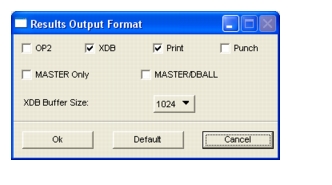
Data Output | Defines the type of data output. |
• OP2 | Specifies output of data to a MD Nastran OUTPUT2 file (*.op2). This will place a PARAM, POST, -1 in the input file. |
• XDB | Specifies output of data to a MSC.Access database (*.xdb). This will place a PARAM, POST, 0 in the input file. |
• Print | Specifies output of data to a MD Nastran print file (*.f06). |
• Punch | Specifies output of data to a MD Nastran punch file (*.pch). |
• MASTER Only | When ON, only a .master file is written. |
• MASTER/DBALL | When ON, both a .master file and a .dball file are written. |
• XDB Buffer Size | For the XDB results file, defines the buffer size used for accessing results. |
OUTPUT2 Requests | Specifies type of OUTPUT2 commands. • P3 Built In - signals the use of MD Nastran internal OUTPUT2 commands geared toward Patran. These commands are also appropriate for PATRAN 2. The “P3 Built In” option is appropriate only for Database Runs, see Solution Parameters, 268. If Database Run has been deselected, this option will be set internally to “Alter File”. • Alter File - specifies the use of an external alter file found on the Patran file path and following the “msc_v#_sol#.alt” naming convention. See Files, 550 for more details. |
• CADA-X Alter - specifies the use of an LMS CADA‑X specific alter file that is identical to the “Alter File” but with an additional “.lms” extension, for example, “msc_v67_sol103.alt.lms”. • P2 Built In - specifies use of MD Nastran internal OUTPUT2 commands geared toward PATRAN 2. | |
OUTPUT2 Format | Specifies format of the MD Nastran OUTPUT2 (*.op2) files. Use “Text” format when the resulting OUTPUT2 file must be transported between heterogeneous computer platforms. |
NASTRAN_nnn_DATA_OUTPUT OP2+PUNCH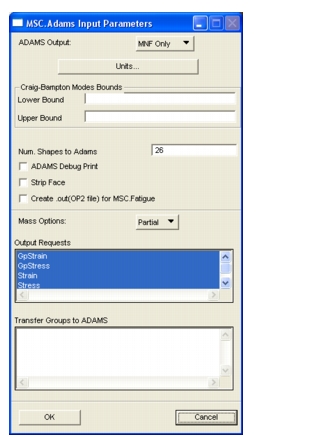
ADAMS Output | • MNF Only • Full Run + MNF |
Units | • Mass - Your options are: Kilogram, Pound-Mass, Slug, Gram, Ounce-Mass, Kilo-Pound-Mass, Megagram • Force - Newton, Pounds-Force, Ounce-Force, Dyne, Kilo-Newton, Kilo-Pound-Force • Length - Millimeter, Centimeter, Meter, Kilometer, Inch, Foot, Mile • Time - Millisecond, Second, Minute, Hour |
Craig-Bampton Modes Bounds | • Lower Bound • Upper Bound |
Num. Shapes to Adams | |
ADAMS Debug Print | |
Strip Face | |
Create .out(OP2 file) for MSC Fatigue | |
Mass Options | • Partial • Constant File • Full • None |
Output Requests | |
Transfer Groups to ADAMS |